Royal Military Canal (3)
Posted: 13 February 2007 23:28
I've just looked in the mirror and realised why people on the train were giving me funny looks; I have several splashes of dried mud on my face, in my hair and up the front of my fleece jacket.
Having spent the past few days hurriedly belting out page after page for my delayed-action pillbox website (still about 50 more to do - sorry - not long now though!), I've worked my way through hundreds of pillbox photographs.
Last Sunday I had one of those moments that I occasionally have whereby I spot something in a photo that has some significance that I completely failed to clock when I was there.
The photograph in question was of a Type 22 pillbox along the Royal Military Canal that I visited during my first cycling trip on 7 June 2006.
A quick look at the weather forecast online showed that yesterday was going to be windy with heavy showers, so I gave it a miss. However, today's forecast showed up sunny, so I hopped onto a train to Ham Street with my bike to go and have a second look.
I'll keep you in suspense for a bit (actually, I'll be honest; I'm not going to tell you exactly what I was looking for in this post - I need to do some thinking before I write a subsequent post in the next few days - don't let me stop you from reading on though...)
I was intending to look at just two pillboxes, both of which I had previously visited.
One problem I had overlooked was that this was mid-February; cycling along the banks of the canal in summer is quite a simple matter; in winter it's a nightmare. Not only was I getting mud in my face (I thought I'd cleaned it all off before I got on the train), but my progress was painfully slow. In a low gear, the effort required to pedal along was about twice as much as in summer. The ground was waterlogged and my wheels kept slipping. Very frustrating!
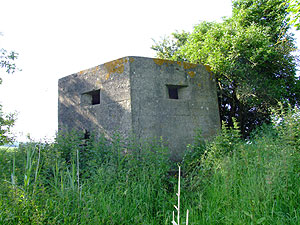
I arrived exhausted at the first pillbox of the day: a Type 22 at Bilsington.
I wanted to see this one again, as I had been unable to enter it during my previous visit back in June; the photo at right was taken on that trip.
The reason for this was the extensive patch of 2-foot high stinging nettles guarding the entrance; in summer I wear shorts when cycling, and as I was in a hurry, I had no inclination to trample my way several metres through hostile vegetation. I did manage to get to the canal side of the pillbox and take some pics through one embrasure, at the expense of a legful of stings though.
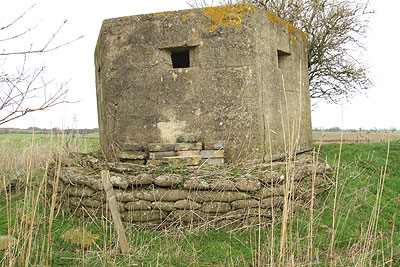
The main reason to see this one again was because William Foot, in his book The Battlefields that Nearly Were (Tempus Publishing, 2006), makes reference to the concrete sandbag base that was completely invisible last June due to nettles. This is illustrated by the fact that both of the photos were taken from almost the same viewpoint!
The sandbag underpinning extends round three quarters of the pillbox base slab.
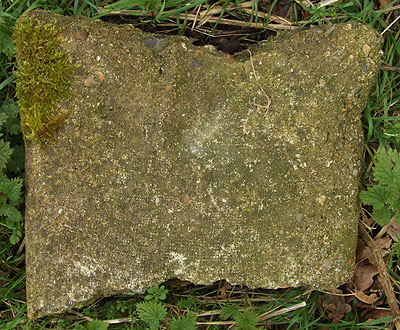
The photo shows a displaced 'broken' sandbag; the hessian pattern is visible on the surface. A quick flick of the tape measure showed that a complete sandbag was the regulation 30 x 60 cm.
I've not seen this technique before; it seems strange to me that the concrete sandbags appear to have set hard before they were put in place; they've been built up like a dry stone wall.
I expect they were installed after the pillbox was constructed to shore it up; a task they're now gradually failing to perform, judging by the angle at which the pillbox is now tilting.
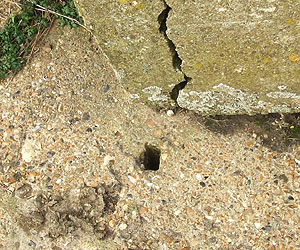
One last feature I noticed was this 15cm-deep hole on the concrete base slab upon which the pillbox stands; was this for a stake to hold the wooden shuttering in place during construction?
Subsidence has caused the pillbox to move several inches over the years, as illustrated by the crack.
I had a quick look, but couldn't find any other similar sockets in the slab; something to look out for in future.
I peddled (or should that be paddled?) my way back to the road, ready to set out for my ultimate target of the day...
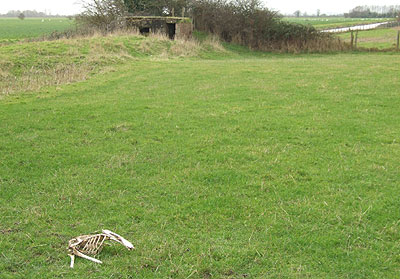
I was met by a scene of death and destruction at the centre of today's attention; judging by the feathers out of shot, the skeletal remains in the foreground belonged to either a goose or a swan.
The Type 22 pillbox in the background was the reason for my trip; I wasn't going to be disappointed either.
Again, the presence of extensive summer undergrowth, coupled with the urgent need to reach the nearest railway station in time to catch the last train caused me to miss vital evidence durng my previous visit.
Not this time though; I spent just over two hours in and around this particular pillbox, taking photographs and measuring it up certain dimensions. All will be explained in my next post...
Realising that I needed to be making for home, I paddled my way back to the road and cycled back to Ham Street to catch the train.
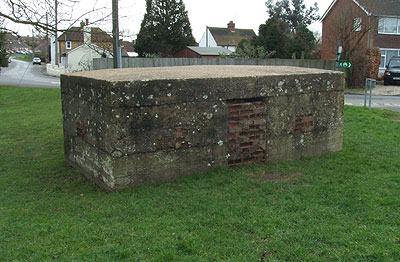
I took a slight wrong turning and came across an old friend from my second trip back in September in the form of this Type 24.
I should point that I nearly got killed twice today; the first occasion when I nearly fell into the Royal Military Canal whilst taking a photo of the first Type 22.
Then, on my way back to Ham Street, my rear wheel skidded on a patch of wet mud. I found myself on the wrong side of the road before I regained control, thankfully moving back before oncoming traffic turned me into Pete patè; fortunately, there was nothing behind me.
Having reached Ham Street with time to spare, I dropped into the local shop to grab some food at a cost £3.34; paying with a £10 note, my change amounted to 666...
Fortunately I'm not superstitious, so I'll be around for long enough to tell you the real purpose of my activities today...
- Pete

Email:
Blog Latest

Bishopstone reveals its pillbox secrets
18 October 2021

Pillbox or Observation Post?
10 June 2020

Uncovering the hidden secrets of a pillbox
8 June 2019

Review of 2018
31 December 2018

Wartime Christmas in East Sussex (2)
24 December 2018
Jargon-buster
Embrasure
A loophole or slit that permits observation and/or weapons to be fired through a wall or similar solid construction.
Pillbox
Generic term for a hardened field defensive structure usually constructed from concrete and/or masonry. Pillboxes were built in numerous types and variants depending on location and role.
Sockets
Concrete-lined shafts dug into road surfaces into which rails or RSJs (hairpin or straight) could be inserted to form a roadblock. When not in use, a wooden cover was placed over each socket.

Type 22 pillbox
A small hexagonal pillbox for six men not commonly seen in East Sussex, though a few still survive along the Royal Military Canal stop line.
This site is copyright © Peter Hibbs 2006 - 2024. All rights reserved.
Hibbs, Peter Royal Military Canal (3) (2024) Available at: http://pillbox.org.uk/blog/216518/ Accessed: 27 July 2024
The information on this website is intended solely to describe the ongoing research activity of The Defence of East Sussex Project; it is not comprehensive or properly presented. It is therefore NOT suitable as a basis for producing derivative works or surveys!